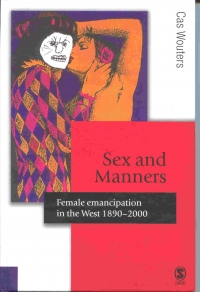Sex and Manners : Female Emancipation in the West 1890 - 2000 (Theory, Culture and Society Series)
Wouters, Cas
Sage Publications, London
2004
181 pp.
0803983697
 Cas Wouters offers a cross cultural comparison of etiquette 'manners' books and magazines that were popular during the 20th Century in the UK, the USA, Germany and the Netherlands. The book is peppered with quotes from these publications, as it moves from courtship to sexual morality. He looks at the advice given about courtship, dancing, dating, engagement and marriage. He conceptualises the relationship between men and women as the 'lust balance', the tension between 'the longing for sexual gratification and the longing for enduring intimacy' (p6), and argues this to be one of the central themes of manners books.
Cas Wouters offers a cross cultural comparison of etiquette 'manners' books and magazines that were popular during the 20th Century in the UK, the USA, Germany and the Netherlands. The book is peppered with quotes from these publications, as it moves from courtship to sexual morality. He looks at the advice given about courtship, dancing, dating, engagement and marriage. He conceptualises the relationship between men and women as the 'lust balance', the tension between 'the longing for sexual gratification and the longing for enduring intimacy' (p6), and argues this to be one of the central themes of manners books.
My first impression was that this book might be hard work, as I found the Introduction rather lacklustre. Thereafter, however, it livened up, and was both instructive and entertaining. Many of the ideas, warnings, and directives were only too familiar to me growing up in the 1950s and 1960s. For example, not to go 'too far' with a boy, thus damaging one's reputation, hand-me- down advice from parents who were young in the pre-World War II period.
Wouters takes an explicit perspective from Elias on the development of manners books, and uses these to illustrate some structural changes of the last 100 years. He makes clear the levelling out of fashions and tastes and the mixing of lower and working class manners that were previously completely separate.
His contrasts and comparisons between the four countries raise, and answer, interesting questions. For example, the American courtship regimes differed as their structured dating system, a form of internal control, replaced the need for chaperones - external control - that continued to be the practice until well into the 20th Century in the other three countries. Youth culture also emerged earlier in the US, linked to the development of an 'upper class' of college students.
A number of interesting insights emerge concerning differences in social history and cultural processes at various periods, for example the Netherlands non-involvement in World War I meant social etiquette did not pass through the same stages as, and remained more conservative than the other three countries during the 1920s and 30s at that time.
Central to the book is the theme of power, and its expression, between men and women. Wouters examines the feminist movement, highlighting a move in manners books to sex promoted for its own sake, rather than as a use or abuse of power. He proposes that the 1990s are characterised by an 'integration and civilisation' of the sexes, and that manners books demonstrate people becoming more 'sensitive and flexible in all relationships', including sexual ones (p. 150). His conclusion strikes an intuitive chord as he foresees the future as characterised by a continuing, but different type of lust balance' struggle. He believes men and women today are 'egalitarian on the surface and traditional underneath' (p. 160); many of us would doubtless concur.
This text would be of interest to those teaching or studying social history, sociologies of the body, emotion, or industry, and also feminist, gender, media and cultural studies. It would probably be of most use to students already familiar with the work of Elias, rather than those at an early stage of study. This book is also potentially a good read for the non academic who has a curiosity about etiquette, but I am not convinced that the quoted passages would be so intriguing to people in their 20s today as they were to me.
The style can be a little ungainly at times but the merits of this book outweigh this difficulty.
Jenny Greener
Postgraduate student at Manchester University

